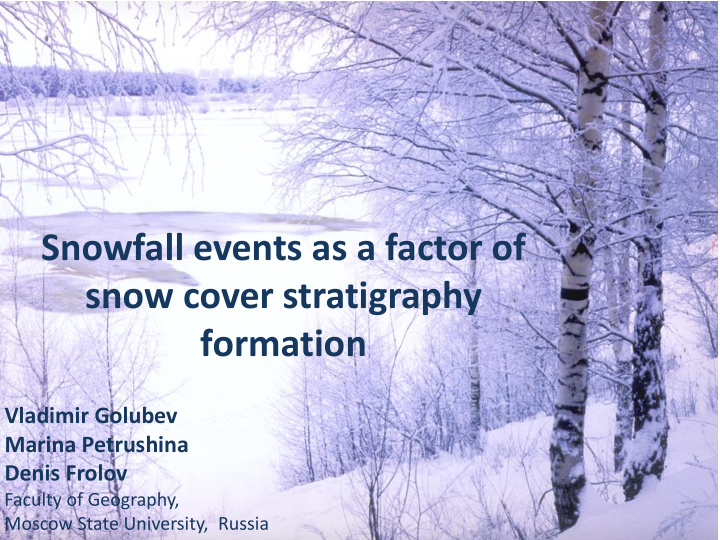



Snowfall events as a factor of snow cover stratigraphy formation Vladimir Golubev Marina Petrushina Denis Frolov Faculty of Geography, Moscow State University, Russia
Introduction The aim - to reveal the role of snowfalls for the stratigraphy formation of the snow cover and to model generalized regional stratigraphy of snow cover for the various regions. Snowfall is an event with one or several day duration under conditions of daily precipitation intensity more than 0.1 mm and presence of snow cover. Snowfalls’ intensity is the quantity of precipitation (its snow water equivalent) during this snowfall.
Introduction In present work it is continued to apply presented in [1] methodic for characterization of regional stratigraphy and snow water equivalent of snow cover on the base of meteorological data. In this methodic in particular assumed, that formation of the different snow layers in snow thickness is the result of separate snowfalls (as well as thaws, strong winds etc.) and the number and water equivalent of snow layers correspond to the number and water equivalent of snowfalls of winter season. 1. Golubev, V.N.; Petrushina, M.N.; Frolov, D.M. Winter regime of temperature and precipitation as a factor of snow-cover distribution and its stratigraphy. Annals of Glaciology 2008, 49, 179 – 186.
Data base winters of 1960-2016 (November – March) 45 meteostations in all climatic areas of Russia (no less than 2 in each of them)
Variations of mean temperature (a), sum precipitation (b) and snow cover thickness (c) for winter seasons of 1966-2017 a b c 1.Similar trends of characteristics with differences in years 2.Increase of winter temperature 3.Increase of precipitation 4.Increase of snow cover thickness 5.Contrasts between years 6.Decreasing of anomaly high winter temperature during last years within the major part of Russia Coefficients of liner trend of days with anomaly high temperature (days/10 year): в) – summer ; г) – winter (Bulygina, et all, 2015).
Anomalies of temperature (a), precipitation (b) and snow cover thickness (c) for winter seasons 2009/10 and 2014/15 Inter-annual variability of meteorological conditions became more contrast 2010 was characterized by extremely cold winter with some deficit of precipitation in the Central Asia, more humid in some regions of Far East. Various changes of this meteorological parameters within different regions of the country
Distribution of snowfalls frequency (a) and mean intensity (b) on the territory of Russia in 1961-2015 a b • The meridional alternation of zones with high frequency of snowfalls (25-30/per season) and zones with low frequency of snowfalls (15-25/per season) • Decreasing the frequency of snowfalls in some regions with increasing of their intensity (European part, eastern part of Western Siberia) • The increasing of heavy snowfalls on the European part, Kamchatka and some regions of south of Far East.
Distribution of snowfalls frequency with intensity: (a) 0.1 – 2.5 mm; (b) 2.5-5 mm; (c) 5-10mm for the averaged winter period 1960 -2016 Moscow region stratigraphic columns for the maximum of snow accumulation: (d) – modeled, generalized-averaged for winter seasons 1960-2016; (e) – real observations for winter season 2014/15. Snow stratigraphy notation: (1) – new snow; (2) – fine-grained snow; (3) – medium-grained snow; (4) – coarse-grained snow; (5) – faceted crystals; (6) – refrozen ice crystals; (7) – ice crust.
Variations of mean temperature (a), sum precipitation (b) and snow cover thickness (c) in Moscow region for winter seasons of 1961-2017 a c b
Snow cover stratigraphy in Moscow region for winter season 2012/2013 Real columns for Moscow region for winter 2012/13 Modeled column forest, field (Bitsa) for Moscow region for winter 2012/13 birch, pine, spruce forest; field (Central Botanic garden) In winter season of 2012/13 there were in Moscow 4 snowfalls with intensity more than 20 mm (47, 31, 27, 44 mm), 4 with 10-20 (13, 19, 11, 15 mm), 3 with 5-10 (6,8, 7, 8 mm), 1 with 2,5-5 (3,5 mm), 4 with less than 2,5 mm. There were totally 16 snowfalls.
Conclusions • The snowfalls frequency (number per season) and intensity for the winter 1960-2016 are determined on the base of methodic suggested in our previous work. • The maps of distribution of averaged for the considered time-period number of snowfalls of the defined intensity (0.1-2.5, 2.5-5, 5-10, 10-20 and more than 20 mm) are compiled. • The tendency of variation from the areas with predominance of the snowfalls with low intensity (0.1-2.5 mm) (Central and North-East Yakutia) (up to 26 snowfalls per season) towards the areas with predominance of the snowfalls with medium intensity (2.5-5 and 5-10 mm (up to 5-8 and 4 snowfalls per season correspondingly) at European territory of Russia and on the coasts of Bering, Okhotsk and Japan seas) has been revealed • The modelled generalized regional stratigraphy of snow cover has a good verification with really observed snow cover stratigraphy for Moscow region. The difference of modelled and real stratigraphy may be explained by the fact that not all events (such as thaws, strong wind and so on) were taken into account.
Thank you for attention
Recommend
More recommend